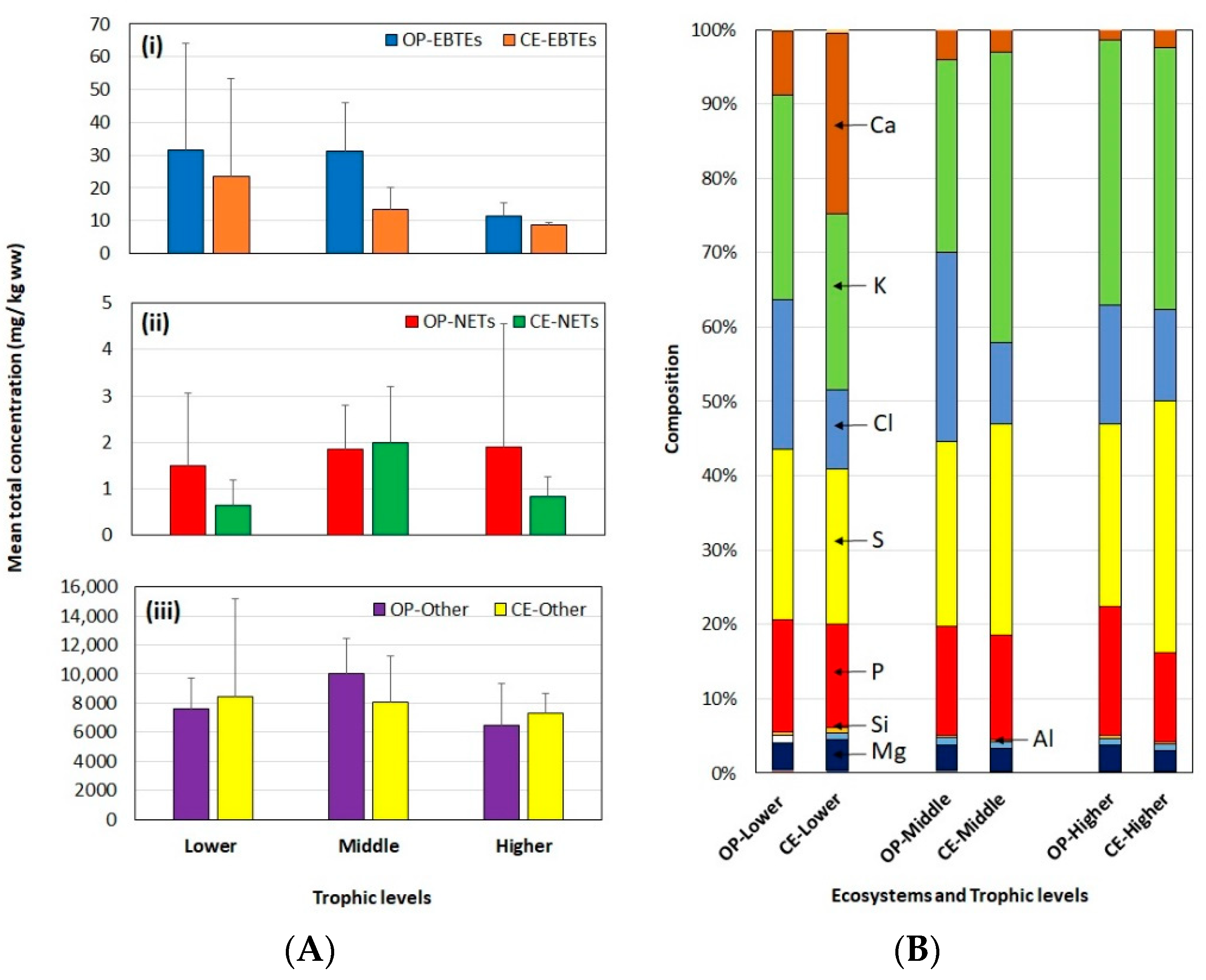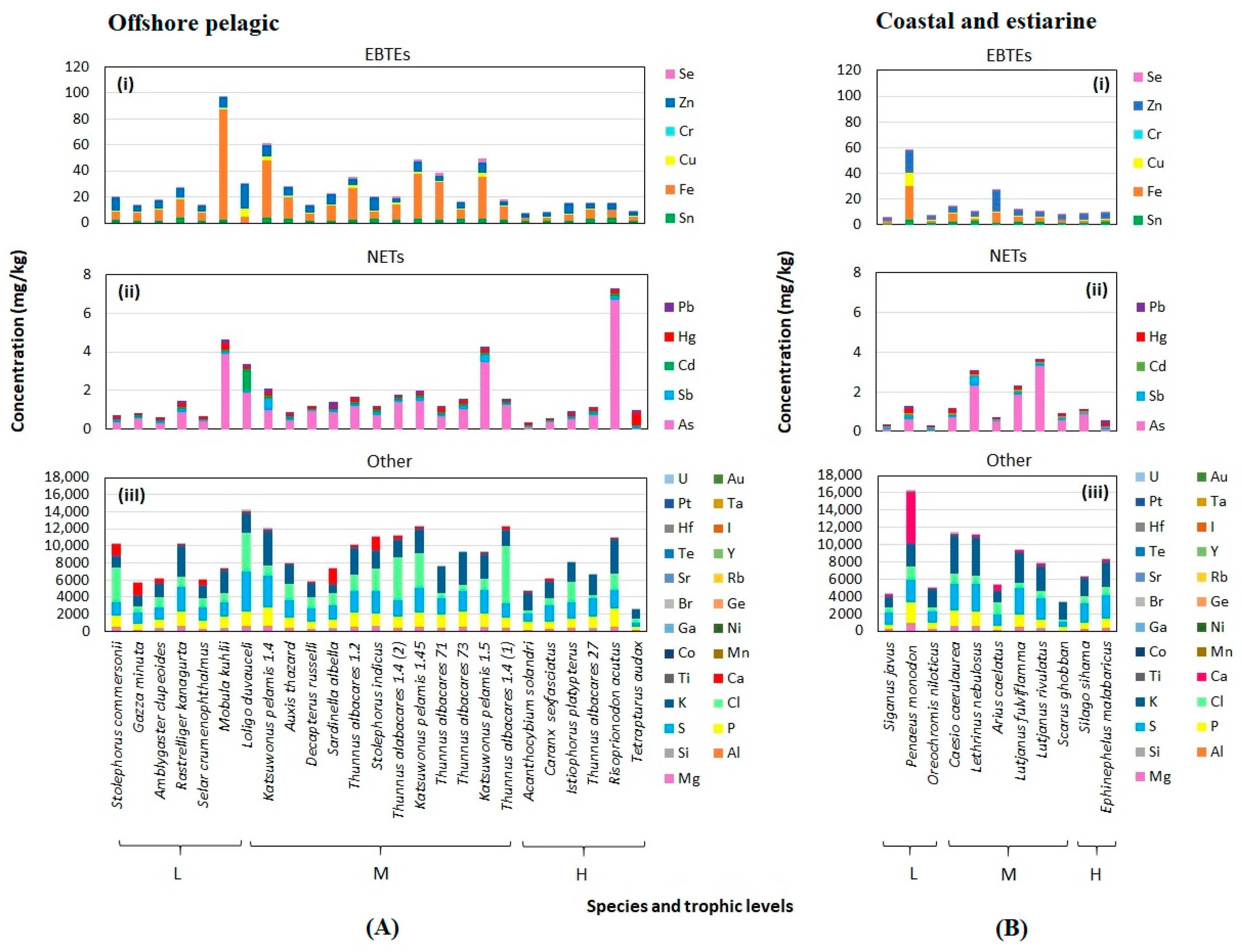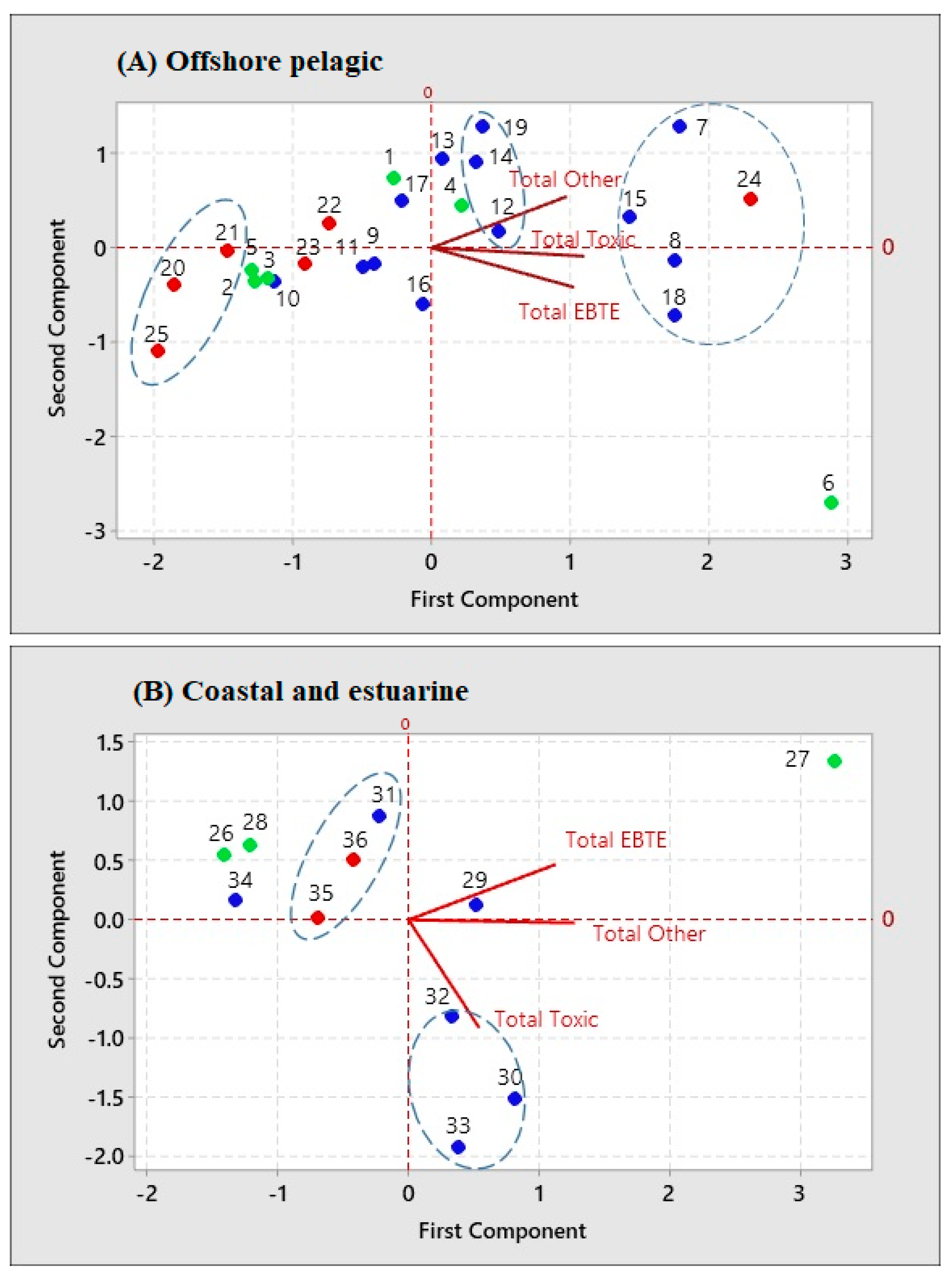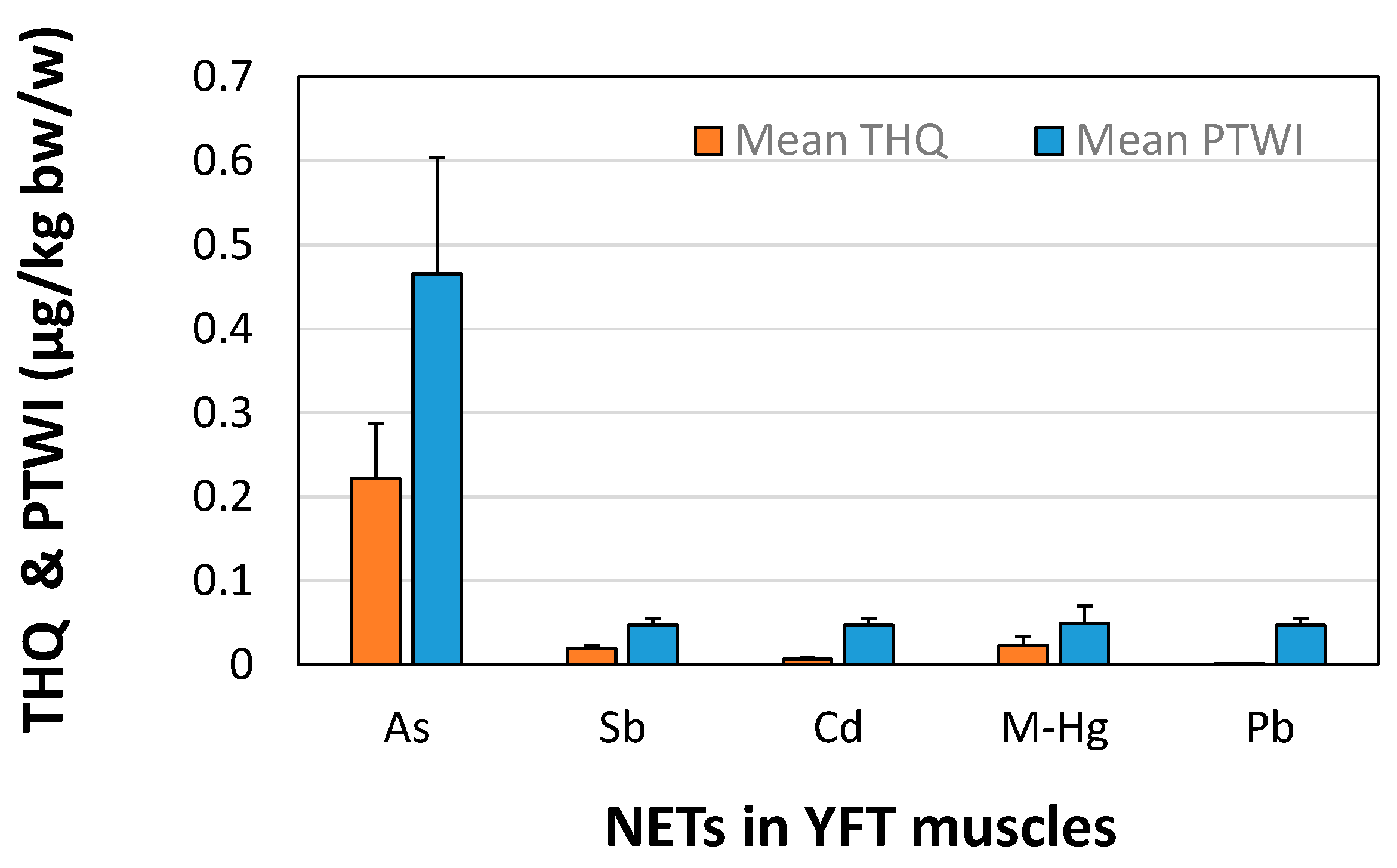Comparative Study on the Distribution of Essential, Non-Essential Toxic, and Other Elements across Trophic Levels in Various Edible Aquatic Organisms in Sri Lanka and Dietary Human Risk Assessment
Abstract
:1. Introduction
2. Materials and Methods
2.1. Sample Collection
2.2. Toxic and Other Elements
2.3. Sample Preparation and Analysis
2.4. Stable Isotope Analysis
2.5. Statistical Analysis
2.6. Health Risk Assessment
2.6.1. Estimated Daily Intake (EDI) of T. albacares (YFT)
2.6.2. Target Hazard Quotient (THQ) of Consuming T. albacares (YFT)
2.6.3. Hazard Index (HI)
2.6.4. Provisional Tolerable Weekly Intake (PTWI) for T. albacares (YFT)
3. Results
3.1. Concentrations and TLs vise Accumulation of Elements
3.2. Levels of Toxic and Other Elements in Aquatic Organisms
3.3. Toxic Element Concentrations in Yellowfin and Skipjack Tuna Fish
3.4. Mercury Accumulation in Yellowfin Tuna
3.5. Human Health Risk Assessment of Consuming Yellowfin Tuna
4. Conclusions
Supplementary Materials
Author Contributions
Funding
Institutional Review Board Statement
Informed Consent Statement
Data Availability Statement
Acknowledgments
Conflicts of Interest
References
- Food and Agriculture Organization (FAO). The State of Food and Agriculture, Climate Change, Agriculture and Food Security; Food and Agriculture Organization of the United Nations: Rome, Italy, 2016. [Google Scholar]
- Food and Agriculture Organization (FAO). The State of World Fisheries and Aquaculture, Sustainablility in Action; Food and Agriculture Organization of the United Nations: Rome, Italy, 2020; Volume 32. [Google Scholar]
- Ministry of Fisheries and Aquatic Resource (MOFAR). Fisheries Statistics; Sri Lanka; 2020. Available online: http://www.fisheriesdept.gov.lk/web/images/Statistics/FISHERIES-STATISTICS--2020-.pdf (accessed on 27 September 2022).
- Ababouch, L. Assuring fish safety and quality in international fish trade. Mar. Pollut. Bull. 2006, 53, 561–568. [Google Scholar] [CrossRef] [PubMed]
- Jurowski, K.; Fołta, M.; Tatar, B.; Berkoz, M.; Krośniak, M. The health risk assessment of essential elemental impurities (Cu, Mn and Zn) through the dermal exposure of herbal ointment extracted from marjoram herb (Majoranae herbae extractum). Biol. Trace Elem. Res. 2022, 200, 1981–1987. [Google Scholar] [CrossRef] [PubMed]
- Taiwo, A.M.; Olukayode, S.; Ojekunle, O.Z.; Awomeso, J.A. The toxicological risk assessment of trace elements (Co, Cu, Fe, and Zn) in snacks from Ijebu Ode, Ogun State, Southwest, Nigeria. Biol. Trace Elem. Res. 2021, 199, 4847–4855. [Google Scholar] [CrossRef] [PubMed]
- Al-Ghanim, K.A.; Abdelatty, M.; Abdelfattah, L.; Mahboob, S. Differential uptake of heavy metals by gill, muscles and liver of four selected fish species from red sea. Pak. J. Zool. 2015, 47, 1031–1036. [Google Scholar]
- Madgett, A.S.; Yates, K.; Webster, L.; McKenzie, C.; Moffat, C.F. The concentration and biomagnification of trace metals and metalloids across four trophic levels in a marine food web. Mar. Pollut. Bull. 2021, 173A, 112929. [Google Scholar] [CrossRef]
- Jinadasa, B.K.K.K.; Chathurika, G.S.; Jayaweera, C.D.; Jayasinghe, G.D.T.M. Mercury and cadmium in swordfish and yellowfin tuna and health risk assessment for Sri Lankan consumers. Food Addit. Contam. Part B Surveill. 2019, 12, 75–80. [Google Scholar] [CrossRef]
- Bosch, A.C.; O’Neill, B.; Sigge, G.O.; Kerwath, S.E.; Hoffman, L.C. Heavy metals in marine fish meat and consumer health: A review. J. Sci. Food Agric. 2016, 96, 32–48. [Google Scholar] [CrossRef]
- Laxmi Mohanta, V.; Naz, A.; Kumar Mishra, B. Distribution of heavy metals in the water, sediments, and fishes from Damodar river basin at steel city, India: A probabilistic risk assessment. Hum. Ecol. Risk Assess. Int. J. 2020, 26, 406–429. [Google Scholar] [CrossRef]
- Okoye, E.A.; Bocca, B.; Ruggieri, F.; Ezejiofor, A.N.; Nwaogazie, I.L.; Domingo, J.L.; Rovira, J.; Frazzoli, C.; Orisakwe, O.E. Metal pollution of soil, plants, feed and food in the Niger Delta, Nigeria: Health risk assessment through meat and fish consumption. Environ. Res. 2021, 198, 111273. [Google Scholar] [CrossRef]
- Kumar, D.; Khan, E.A. Remediation and detection techniques for heavy metals in the environment. In Heavy Metals in the Environment; Elsevier: Amsterdam, The Netherlands, 2021. [Google Scholar] [CrossRef]
- Wickrama-Arachchige, A.U.K.; Guruge, K.S.; Inagaki, Y.; Tani, H.; Dharmaratne, T.S.; Niizuma, Y.; Ohura, T. Halogenated polycyclic aromatic hydrocarbons in edible aquatic species of two Asian countries: Congener profiles, biomagnification, and human risk assessment. Food Chem. 2021, 360, 130072. [Google Scholar] [CrossRef]
- Authman, M.M. Use of fish as bio-indicator of the effects of heavy metals pollution. J. Aquac. Res. Dev. 2015, 6, 328. [Google Scholar] [CrossRef]
- Rathnasuriya, M.I.G.; Jinadasa, B.K.K.K.; Madhujith, T. Hair mercury levels and dietary exposure of mercury in relation to fish consumption among coastal population in Negombo, Sri Lanka. Sri Lanka J. Aquat. Sci. 2018, 25, 179–186. [Google Scholar] [CrossRef]
- Erasmus, C.P. The Concentration of Ten Metals in the Tissues of Shark Species Squalus megalops and Mustelus mustelus (Chondrichthyes) Occurring along the Southeastern Coast of South Africa. Ph.D. Thesis, University of Port Elizabeth, Port Elizabeth, South Africa, April 2004; p. 349. [Google Scholar]
- Canli, M.; Atli, G. The relationships between heavy metal (Cd, Cr, Cu, Fe, Pb, Zn) levels and the size of six Mediterranean fish species. Environ. Pollut. 2003, 121, 129–136. [Google Scholar] [CrossRef]
- Jayasinghe, G.D.T.M.; Sandaruwan, K.P.G.L.; Silva, D.W.L.U.; Jinadasa, B.K.K.K. Total Diet Study approach in estimating mercury and cadmium levels using selected fish: A case study from Sri Lanka. Ceylon J. Sci. 2018, 47, 3–8. [Google Scholar] [CrossRef] [Green Version]
- Jinadasa, B.K.K.K.; Edirisinghe, E.M.R.K.B.; Wickramasinghe, I. Total mercury content, weight and length relationship in swordfish (Xiphias gladius) in Sri Lanka. Food Addit. Contam. Part B Surveill. 2013, 6, 244–248. [Google Scholar] [CrossRef] [PubMed]
- Jinadasa, B.K.K.K.; Chathurika, G.S.; Jayasinghe, G.D.T.M.; Jayaweera, C.D. Mercury and cadmium distribution in yellowfin tuna (Thunnus albacares) from two fishing grounds in the Indian Ocean near Sri Lanka. Heliyon 2019, 5, e01875. [Google Scholar] [CrossRef] [PubMed] [Green Version]
- Jinadasa, B.K.K.K.; Fowler, S.W. Critical review of mercury contamination in Sri Lankan fish and aquatic products. Mar. Pollut. Bull. 2019, 149, 110526. [Google Scholar] [CrossRef] [PubMed]
- Jinadasa, B.K.K.K.; Edirisinghe, E.M.R.K.B.; Wickramasinghe, I. Total mercury, cadmium and lead levels in main export fish of Sri Lanka. Food Addit. Contam. 2014, 4, 309–314. [Google Scholar] [CrossRef]
- Jinadasa, B.K.K.K.; Jayasinghe, G.D.T.M.; Edirisinghe, E.M.R.K.B.; Wickramasinghe, I. Mercury Concentration of Muscle Tissue and Relationship with Size of Yellow fin Tuna, Thunnus albacares of the Indian Ocean. Eur. J. Acad. Essays 2015, 2, 35–40. [Google Scholar]
- Jinadasa, B.; Rameesha, L.; Edirisinghe, E.; Rathnayake, R. Mercury, cadmium and lead levels in three commercially important marine fish species of in Sri Lanka. Sri Lanka J. Aquat. Sci. 2010, 15, 39. [Google Scholar] [CrossRef]
- Jurowski, K.; Buszewski, B.; Piekoszewski, W. Bioanalytics in quantitive (bio) imaging/mapping of metallic elements in biological samples. Crit. Rev. Anal. Chem. 2015, 45, 334–347. [Google Scholar] [CrossRef] [PubMed]
- Albu, P.; Herman, H.; Balta, C.; Lazar, V.; Fulop, A.; Baranyai, E.; Harangi, S.; Keki, S.; Nagy, L.; Nagy, T.; et al. Correlation between heavy metal-induced histopathological changes and trophic interactions between different fish species. Appl. Sci. 2021, 11, 3760. [Google Scholar]
- Mason, R.P.; Coulibaly, M.; Hansen, G.; Inman, H.; Myer, P.; Yao, K.M. Human impacts on mercury levels in the aquatic environment and coastal seafood of Cote d’Ivoire. SSRN Electron. J. 2021, 1–38. [Google Scholar] [CrossRef]
- Bosch, A.C.; O’Neill, B.; Sigge, G.O.; Kerwath, S.E.; Hoffman, L.C. Mercury accumulation in yellowfin tuna (Thunnus albacares) with regards to muscle type, muscle position and fish size. Food Chem. 2016, 190, 351–356. [Google Scholar] [CrossRef] [PubMed]
- Koleleni, Y.A.; Haji, O.O. Determination of concentration of heavy metals in fish from sea port of Zanzibar by energy dispersive x-ray fluorescence (EDXRF). Tanzan. J. Sci. 2014, 40, 70–79. [Google Scholar]
- Wickrama-Arachchige, A.U.; Hirabayashi, T.; Imai, Y.; Guruge, K.S.; Dharmaratne, T.S.; Ohura, T. Accumulation of halogenated polycyclic aromatic hydrocarbons by different tuna species, determined by high-resolution gas chromatography Orbitrap mass spectrometry. Environ. Pollut. 2020, 256, 113487. [Google Scholar] [CrossRef]
- Fry, B. Stable Isotope Ecology, 1st ed.; Springer: Cham, Switzerland, 2006. [Google Scholar] [CrossRef]
- McClelland, J.W.; Valiela, I.; Michener, R.H. Nitrogen-stable isotope signatures in estuarine food webs: A record of increasing urbanization in coastal watersheds. Limnol. Oceanogr. 1997, 42, 930–937. [Google Scholar] [CrossRef]
- Griffin, M.P.A.; Valliela, I. δ15N isotope studies of life history and trophic position of Fundulus heteroclitus and Menidia menidia. Mar. Ecol.—Prog. Ser. 2001, 214, 299–305. [Google Scholar] [CrossRef] [Green Version]
- Jennings, S.; Mackinson, S. Abundance-body mass relationships in size-structured food webs. Ecol. Lett. 2003, 6, 971–974. [Google Scholar] [CrossRef]
- Wickramanayake, T.W. The growth chart. Sri Lanka J. Child Health 2009, 29, 18. [Google Scholar] [CrossRef]
- Sevillano-Morales, J.S.; Cejudo-Gómez, M.; Ramírez-Ojeda, A.M.; Cámara Martos, F.; Moreno-Rojas, R. Risk profile of methylmercury in seafood. Curr. Opin. Food Sci. 2015, 6, 53–60. [Google Scholar] [CrossRef]
- Razavi, N.R.; Arts, M.T.; Qu, M.; Jin, B.; Ren, W.; Wang, Y.; Campbell, L.M. Effect of eutrophication on mercury, selenium, and essential fatty acids in Bighead Carp (Hypophthalmichthys nobilis) from reservoirs of eastern China. Sci. Total Environ. 2014, 499, 36–46. [Google Scholar] [CrossRef] [PubMed]
- Strandberg, U.; Palviainen, M.; Eronen, A.; Piirainen, S.; Laurén, A.; Akkanen, J.; Kankaala, P. Spatial variability of mercury and polyunsaturated fatty acids in the European perch (Perca fluviatilis)–Implications for risk-benefit analyses of fish consumption. Environ. Pollut. 2016, 219, 305–314. [Google Scholar] [CrossRef]
- Keshavarzi, B.; Hassanaghaei, M.; Moore, F.; Rastegari Mehr, M.; Soltanian, S.; Lahijanzadeh, A.R.; Sorooshian, A. Heavy metal contamination and health risk assessment in three commercial fish species in the Persian Gulf. Mar. Pollut. Bull. 2018, 129, 245–252. [Google Scholar] [CrossRef]
- Özden, Ö.; Erkan, N.; Kaplan, M.; Karakulak, F.S. Toxic metals and omega-3 fatty acids of bluefin tuna from aquaculture: Health risk and benefits. Expo. Health 2020, 12, 9–18. [Google Scholar] [CrossRef]
- US Environmental Protection Agency (USEPA). United States Environmental Protection Agency (USEPA) Regional Screening Level (RSL) Summary Table; US Environmental Protection Agency (USEPA): Washington, DC, USA, 2011.
- Gladyshev, M.I.; Sushchik, N.N.; Anishchenko, O.V.; Makhutova, O.N.; Kalachova, G.S.; Gribovskaya, I.V. Benefit-risk ratio of food fish intake as the source of essential fatty acids vs. heavy metals: A case study of Siberian grayling from the Yenisei River. Food Chem. 2009, 115, 545–550. [Google Scholar] [CrossRef]
- US Environmental Protection Agency (USEPA). Region III Risk-Based Concentration Table: Technical Background Information; US Environmental Protection Agency (USEPA): Washington, DC, USA, 2006.
- Núñez, R.; García, M.Á.; Alonso, J.; Melgar, M.J. Arsenic, cadmium and lead in fresh and processed tuna marketed in Galicia (NW Spain): Risk assessment of dietary exposure. Sci. Total Environ. 2018, 627, 322–331. [Google Scholar] [CrossRef] [PubMed]
- Pinto, E.; Almeida, A.; Ferreira, I.M.P.L.V.O. Essential and non-essential/toxic elements in rice available in the Portuguese and Spanish markets. J. Food Compos. Anal. 2016, 48, 81–87. [Google Scholar] [CrossRef]
- Joint FAO/WHO Expert Committee on Food Additives (JECFA). Safety Evaluation of Certain Food Additives and Contaminants; Prepared by the Forty-Ninth Meeting of the Joint FAO/WHO Expert Committee on Food Additives (JEFCA); World Health Organization: Geneva, Switzerland, 1998. [Google Scholar]
- Joint FAO/WHO Expert Committee on Food Additives (JECFA). Toxicological Evaluation of Certain Food Additives and Contaminants; WHO Food Additives Series; World Health Organization: Geneva, Switzerland, 1989. [Google Scholar]
- Tollefson, L.; Cordle, F. Methylmercury in fish: A review of residue levels, fish consumption and regulatory action in the United States. Environ. Health Perspect. 1986, 68, 203–208. [Google Scholar] [CrossRef]
- Falcó, G.; Llobet, J.M.; Bocio, A.; Domingo, J.L. Daily intake of arsenic, cadmium, mercury, and lead by consumption of edible marine species. J. Agric. Food Chem. 2006, 54, 6106–6112. [Google Scholar] [CrossRef]
- Joint FAO/WHO Expert Committee on Food Additives (JECFA). Summary and Conclusions of the 61st Meeting of the Joint FAO/WHO Expert Committee on Food Additives (JECFA); World Health Organization: Geneva, Switzerland, 2003. [Google Scholar]
- Fang, Z.Q.; Cheung, R.Y.H.; Wong, M.H. Heavy metal concentrations in edible bivalves and gastropods available in major markets of the Pearl River Delta. J. Environ. Sci. 2001, 13, 210–217. [Google Scholar]
- World Health Organization (WHO). Guidelines for Drinking-Water Quality, 3rd ed.; Incorporating First and Second Addenda; World Health Organization (WHO): Geneva, Switzerland, 2008. [Google Scholar]
- Rahman, M.S.; Molla, A.H.; Saha, N.; Rahman, A. Study on heavy metals levels and its risk assessment in some edible fishes from Bangshi River, Savar, Dhaka, Bangladesh. Food Chem. 2012, 134, 1847–1854. [Google Scholar] [CrossRef]
- Pragnya, M.; Ajay, B.; Kumar, S.D.; Byragi Reddy, T. Bioaccumulation of heavy metals in different trophic levels of aquatic ecosystems with fish as a bioindicator in Visakhapatnam, India. Mar. Pollut. Bull. 2021, 165, 112162. [Google Scholar] [CrossRef] [PubMed]
- Tarley, C.R.T.; Coltro, W.K.T.; Matsushita, M.; De Souza, N.E. Characteristic levels of some heavy metals from Brazilian canned sardines (Sardinella brasiliensis). J. Food Compos. Anal. 2001, 14, 611–617. [Google Scholar] [CrossRef]
- Copat, C.; Bella, F.; Castaing, M.; Fallico, R.; Sciacca, S.; Ferrante, M. Heavy metals concentrations in fish from Sicily (Mediterranean Sea) and evaluation of possible health risks to consumers. Bull. Environ. Contam. Toxicol. 2012, 88, 78–83. [Google Scholar] [CrossRef] [PubMed] [Green Version]
- Abdel-Mohsien, H.S.; Mahmoud, M.A.M. Accumulation of Some Heavy Metals in Oreochromis niloticus from the Nile in Egypt: Potential Hazards to Fish and Consumers. J. Environ. Prot. 2015, 6, 1003–1013. [Google Scholar] [CrossRef] [Green Version]
- European Commission (EC). Commission Regulation N. 1881/2006 of 19 December 2006—Setting maximum levels of certain contaminants in foodstuff. Off. J. Eur. Union 2006, 64, 5–24. [Google Scholar]
- Australia New Zealand Food Authority (ANFA). Australian Food Standards Code; Australia New Zealand Food Authority: Canberra, ACT, Australia, 1992.
- Lemly, A.D. A procedure for NEPA assessment of selenium hazards associated with mining. Environ. Monit. Assess. 2007, 125, 361–375. [Google Scholar] [CrossRef]
- South African Department of Health (DOH). Foodstuffs, cosmetics and disinfectants act, 1972 (Act no. 54 of 1972). In Government Gazette No. R. Volume 500; South African Department of Health: Pretoria, South Africa, 2004. [Google Scholar]
- Food and Agriculture Organization (FAO). Heavy Metals Regulations Legal Notice; Food and Agriculture Organization (FAO): Rome, Italy, 2003; Volume 66/2003. [Google Scholar]
- Perera, H.A.C.C.; Haputhanthri, S.S.K.; Bandaranayake, K.H.K. A Review on Oceanic Tuna Fishery in Sri Lanka and Estimation of the Length–Weight Relationships for Yellowfin Tuna and Bigeye Tuna; IOTC–2013–WPTT15–16; Food and Agriculture Organization (FAO): Rome, Italy, 2013; Volume 4, pp. 1–8. [Google Scholar]
- Vieira, H.C.; Bordalo, M.D.; Morgado, F.; Soares, A.M.V.M.; Abreu, S.N. Mercury content in the white and dark muscle of Skipjack tuna (Katsuwonus pelamis) along the canning process: Implications to the consumers. J. Food Compos. Anal. 2017, 56, 67–72. [Google Scholar] [CrossRef]
- Karunarathna, K.A.A.U.; Attygalle, M.V.E. Mineral Spectrum in different body parts of five species of tuna consumed in Sri Lanka. Vidyodaya J. Sci. 2009, 14, 103–111. [Google Scholar]
- Lacerda, L.D.; Goyanna, F.; Bezerra, M.F.; Silva, G.B. Mercury Concentrations in Tuna (Thunnus albacares and Thunnus obesus) from the Brazilian Equatorial Atlantic Ocean. Bull. Environ. Contam. Toxicol. 2017, 98, 149–155. [Google Scholar] [CrossRef] [PubMed]
- Nicklisch, S.C.T.; Bonito, L.T.; Sandin, S.; Hamdoun, A. Mercury levels of yellowfin tuna (Thunnus albacares) are associated with capture location. Environ. Pollut. 2017, 229, 87–93. [Google Scholar] [CrossRef] [PubMed] [Green Version]
- Ordiano-Flores, A.; Rosíles-Martínez, R.; Galván-Magaña, F. Biomagnification of mercury and its antagonistic interaction with selenium in yellowfin tuna Thunnus albacares in the trophic web of Baja California Sur, Mexico. Ecotoxicol. Environ. Saf. 2012, 86, 182–187. [Google Scholar] [CrossRef] [PubMed]
- Ordiano-Flores, A.; Galván-Magaña, F.; Rosiles-Martínez, R. Bioaccumulation of mercury in muscle tissue of yellowfin tuna, Thunnus albacares, of the eastern Pacific Ocean. Biol. Trace Elem. Res. 2011, 144, 606–620. [Google Scholar] [CrossRef]
- Kojadinovic, J.; Potier, M.; Le Corre, M.; Cosson, R.P.; Bustamante, P. Mercury content in commercial pelagic fish and its risk assessment in the Western Indian Ocean. Sci. Total Environ. 2006, 366, 688–700. [Google Scholar] [CrossRef] [PubMed]
- Saleh, Y.S.; Busaadia, M.A. Dietary metal intake from four widely consumed marine fish species and its repercussions for human health at the west coast of Yemen. Reg. Stud. Mar. Sci. 2022, 50, 102153. [Google Scholar] [CrossRef]
- Castro-González, M.I.; Méndez-Armenta, M. Heavy metals: Implications associated to fish consumption. Environ. Toxicol. Pharmacol. 2008, 26, 263–271. [Google Scholar] [CrossRef]
- Llobet, J.M.; Falcó, G.; Casas, C.; Teixidó, A.; Domingo, J.L. Concentrations of arsenic, cadmium, mercury, and lead in common foods and estimated daily intake by children, adolescents, adults, and seniors of Catalonia, Spain. J. Agric. Food Chem. 2003, 51, 838–842. [Google Scholar] [CrossRef]
- Ysart, G.; Miller, P.; Croasdale, M.; Crews, H.; Robb, P.; Baxter, M.; De L’Argy, C.; Harrison, N. UK Total Diet Study dietary exposures to aluminium, arsenic, cadmium, chromium, copper, lead, mercury, nickel, selenium, tin and zinc. Food Addit. Contam. 2000, 17, 775–786. [Google Scholar] [CrossRef]
- Zoorob, G.K.; McKiernan, J.W.; Caruso, J.A. ICP-MS for elemental speciation studies. Mikrochim. Acta 1998, 128, 145–168. [Google Scholar] [CrossRef]
- Tighe, M.; Ashley, P.; Lockwood, P.; Wilson, S. Soil, water, and pasture enrichment of antimony and arsenic within a coastal floodplain system. Sci. Total Environ. 2005, 347, 175–186. [Google Scholar] [CrossRef]
- Wu, F.; Fu, Z.; Liu, B.; Mo, C.; Chen, B.; Corns, W.; Liao, H. Health risk associated with dietary co-exposure to high levels of antimony and arsenic in the world’s largest antimony mine area. Sci. Total Environ. 2011, 409, 3344–3351. [Google Scholar] [CrossRef] [PubMed]
- Henry, A.; Schroeder, H.A.; Darrow, D.K. Relation of trace metals to human health. Boston Coll. Environ. Aff. Law Rev. 1972, 2, 222–236. [Google Scholar]
- Nussey, G.; Van Vuren, J.H.J.; Du Preez, H.H. Bioaccumulation of chromium, manganese, nickel and lead in the tissues of the moggel, Labeo umbratus (Cyprinidae), from Witbank Dam, Mpumalanga. Water SA 2000, 26, 269–284. [Google Scholar]
- Muñoz-Olivas, R.; Cámara, C. Speciation related to human. In Trace Element Speciation for Environment, Food and Health; Royal Society of Chemistry: London, UK, 2001. [Google Scholar]
- Carrington, C.D.; Bolger, M.P. An exposure assessment for methylmercury from seafood for consumers in the United States. Risk Anal. Off. Publ. Soc. Risk Anal. 2002, 22, 689–699. [Google Scholar] [CrossRef] [PubMed]
- Boening, D.W. Ecological effects, transport, and fate of mercury: A general review. Chemosphere 2000, 40, 1335–1351. [Google Scholar] [CrossRef]
- Hempel, M.; Chau, Y.K.; Dutka, B.J.; McInnis, R.; Kwan, K.K.; Liu, D. Toxicity of organomercury compounds: Bioassay results as a basis for risk assessment. Analyst 1995, 120, 721–724. [Google Scholar] [CrossRef] [PubMed]
- Silbernagel, S.M.; Carpenter, D.O.; Gilbert, S.G.; Gochfeld, M.; Groth, E.; Hightower, J.M.; Schiavone, F.M. Recognizing and preventing overexposure to methylmercury from fish and seafood consumption: Information for physicians. J. Toxicol. 2011, 2011, 983072. [Google Scholar] [CrossRef]
- Clarkson, T.W.; Vyas, J.B.; Ballatori, N. Mechanisms of mercury disposition in the body. Am. J. Ind. Med. 2007, 50, 757–764. [Google Scholar] [CrossRef]
- Grandjean, P.; Satoh, H.; Murata, K.; Eto, K. Adverse effects of methylmercury: Environmental health research implications. Environ. Health Perspect. 2010, 118, 1137–1145. [Google Scholar] [CrossRef] [Green Version]
- El-Moselhy, K.M.; Othman, A.I.; Abd El-Azem, H.; El-Metwally, M.E.A. Bioaccumulation of heavy metals in some tissues of fish in the Red Sea, Egypt. Egyptian J. Basic Appl. Sci. 2014, 1, 97–105. [Google Scholar] [CrossRef] [Green Version]
- World Health Organization (WHO). Heavy Metals—Environmental Aspects; Environmental Health Criteria: Geneva, Switzerland, 1989. [Google Scholar]
- Nauen, C.E. Compilation of Legal Limits for Hazardous Substances in Fish and Fishery Products; FAO Fisheries Circular; Food and Agriculture Organization (FAO): Rome, Italy, 1983; Volume 764. [Google Scholar]
- Plaskett, D.; Potter, I.C. Heavy metal concentrations in the muscle tissue of 12 species of teleost from Cockburn sound, Western Australia. Mar. Freshw. Res. 1979, 30, 607–616. [Google Scholar] [CrossRef]
- Ahmed, M.K.; Baki, M.A.; Islam, M.S.; Kundu, G.K.; Habibullah-Al-Mamun, M.; Sarkar, S.K.; Hossain, M.M. Human health risk assessment of heavy metals in tropical fish and shellfish collected from the river Buriganga, Bangladesh. Environ. Sci. Pollut. Res. Int. 2015, 22, 15880–15890. [Google Scholar] [CrossRef] [PubMed]
- Food and Drug Administration (FDA). Compliance Program Report of Findings: FY79 Pesticides and Metals in Fish Program; US Department of Health and Human Services, Public Health Service, Food and Drug Administration, Bureau of Foods: Washington, DC, USA, 1982.





| Mean Hg Concentration (mg/kg) | Range | Mean Length (cm)/Weight (kg) | Method | Country | Ocean | Reference |
|---|---|---|---|---|---|---|
| 0.16 ± 0.16 a | 0.02–0.43 | 118/27 | Mercury analyzer (MA 3000, USA) | Sri Lanka | Indian Ocean | This study |
| 0.30 ± 0.18 a | (0.021) to 0.98 mg/kg | 123.4/45.3 | Cold vapor system atomic absorption spectrophotometry | Sri Lanka | Indian Ocean | [24] |
| 0.26 ± 0.29 c | Atomic absorption spectrophotometry | Sri Lanka | Indian Ocean | [19] | ||
| 0.51 ± 0.33 b | - | 74.3 ± 11.4 | Atomic absorption spectrophotometry | Baja California Sur, California | Eastern Pacific Ocean | [69] |
| 0.98 ± 0.69 | - | 92.2 ± 19.5 | Atomic absorption spectrophotometry | Equatorial Zone | Eastern Pacific Ocean | [70] |
| 0.51 ± 0.32 | - | 22 kg/109 cm | Advanced mercury analyzer (combustion analyzer ALTEC 254) | Mozambique channel | Western Indian Ocean | [71] |
| 0.70 ± 0.49 | - | 24 kg/104 cm | Advanced mercury analyzer (combustion analyzer ALTEC 254) | Reunion Island | Western Indian Ocean | [71] |
| 0.77 a | 0.45 to 1.52 mg/kg wet weight | 29.0 to 50.8 kg | Inductively coupled plasma mass spectrometry | South Africa | South Atlantic | [29] |
| 2.75 ± 0.98 b,d | 1.51–4.49 ng/g dry wt | 138.8 cm forked length/58.7 kg | Cold vapor atomic absorption spectroscopy | West Africa | north Atlantic Ocean | [28] |
| 159 ± 79 | 48 to 500 ng·g−1 wet weight | 92 ± 28 cm (forked length/16.8 ± 13.3 kg | Cold vapor atomic absorption spectrometry | Brazil | Equatorial Atlantic Ocean | [67] |
Publisher’s Note: MDPI stays neutral with regard to jurisdictional claims in published maps and institutional affiliations. |
© 2022 by the authors. Licensee MDPI, Basel, Switzerland. This article is an open access article distributed under the terms and conditions of the Creative Commons Attribution (CC BY) license (https://creativecommons.org/licenses/by/4.0/).
Share and Cite
Wickrama-Arachchige, A.U.-K.; Guruge, K.S.; Tani, H.; Dharmaratne, T.S.; Kumara, M.P.; Niizuma, Y.; Ohura, T. Comparative Study on the Distribution of Essential, Non-Essential Toxic, and Other Elements across Trophic Levels in Various Edible Aquatic Organisms in Sri Lanka and Dietary Human Risk Assessment. Toxics 2022, 10, 585. https://doi.org/10.3390/toxics10100585
Wickrama-Arachchige AU-K, Guruge KS, Tani H, Dharmaratne TS, Kumara MP, Niizuma Y, Ohura T. Comparative Study on the Distribution of Essential, Non-Essential Toxic, and Other Elements across Trophic Levels in Various Edible Aquatic Organisms in Sri Lanka and Dietary Human Risk Assessment. Toxics. 2022; 10(10):585. https://doi.org/10.3390/toxics10100585
Chicago/Turabian StyleWickrama-Arachchige, Anura Upasanta-Kumara, Keerthi S. Guruge, Hinako Tani, Tilak Siri Dharmaratne, Marappullige P. Kumara, Yasuaki Niizuma, and Takeshi Ohura. 2022. "Comparative Study on the Distribution of Essential, Non-Essential Toxic, and Other Elements across Trophic Levels in Various Edible Aquatic Organisms in Sri Lanka and Dietary Human Risk Assessment" Toxics 10, no. 10: 585. https://doi.org/10.3390/toxics10100585
APA StyleWickrama-Arachchige, A. U.-K., Guruge, K. S., Tani, H., Dharmaratne, T. S., Kumara, M. P., Niizuma, Y., & Ohura, T. (2022). Comparative Study on the Distribution of Essential, Non-Essential Toxic, and Other Elements across Trophic Levels in Various Edible Aquatic Organisms in Sri Lanka and Dietary Human Risk Assessment. Toxics, 10(10), 585. https://doi.org/10.3390/toxics10100585







